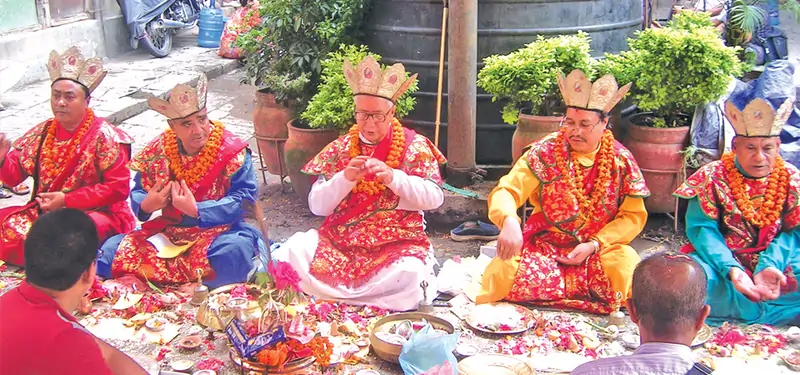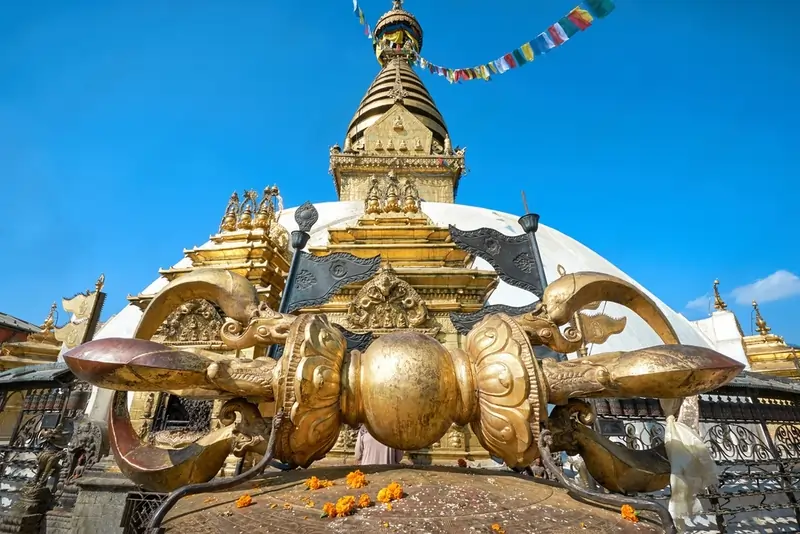Introduction to the Bajracharya
Bajracharyas form a very unique married, normally non-vegetarian priest, within Nepal’s Newar community, deeply versed in the Newar Buddhist Vajrayana traditions. Known colloquially as guru-ju or gu-bhaju, these terms echo the Sanskrit ‘guru’, signifying a teacher or priest. Occupying the highest rank among Newar Buddhist castes, the Bajracharyas are the custodians of ancient spiritual practices.
The term ‘Bajracharya’ itself springs from ‘Vajracharya’, a blend of ‘Vajra’ and ‘Acharya’. The term “Vajra” embodies the idea of being timeless, indestructible, imperceptible, and perpetually existing across the past, present, and future. And ‘Acharya’ means teacher or an expert. Thus, a Vajracharya, or Bajracharya, is essentially a “title” granted as master of the Vajra Doctrine or Vajrayana Buddhism. “Vajracharya” is a title like Doctor, PhD, or Engineer. More than a title, ‘Bajracharya’ symbolizes a commitment to the welfare of all beings and the world at large.

Popular Bajracharyas
Historically, popular Bajracharyas have been figures of immense respect and influence, renowned for their profound expertise in Vajrayana Buddhism and Tantric practices. These experts were not just scholars but also spiritual pioneers, engaging in complex rituals and advanced meditative techniques that set them apart. They achieved feats in spiritual realms that were thought to be unattainable by ordinary practitioners, contributing significantly to the evolution and preservation of their rich traditions. Their lives and works continue to inspire contemporary followers, making them legendary figures within the Bajracharya community and beyond, revered for their extraordinary abilities and deep, transformative insights.
- Manju Dev Acharya (मञ्जु देव आचार्य)
- Gunakar Acharya (गुणाकर आचार्य)
- Shantikar Acharya (शान्तिकार आचार्य)
- Odiyan Acharya (ओडियान आचार्य)
- Bachasiddhi Acharya (बाचाशिद्धी आचार्य)
- Bandhu Dutta Acharya (बन्धूदत्त आचार्य)
- Bajrapad Bajracharya (बज्रपाद बज्राचार्य)
- Omkar Bajra Bajracharya (ॐकार बज्र बज्राचार्य)
- Hunkar Bajra Bajracharya (हूंकार बज्र बज्राचार्य)
- Shaswata Bajra Bajracharya (शाश्वत बज्र बज्राचार्य)
- Wak Bajra Bajracharya (वाक बज्र बज्राचार्य)
- Paramadi Bajra Bajracharya (परमादी बज्र बज्राचार्य)
- Surat Bajra Bajracharya (सुरत बज्र बज्राचार्य)
- Ratna Bajra Bajracharya (रत्न बज्र बज्राचार्य)
- Jeevachandra Bajracharya (जीवचन्द्र बज्राचार्य)
- Lila Bajra Bajracharya (लीला बज्र बज्राचार्य)
- Manju Bajra Bajracharya (मञ्जु बज्र बज्राचार्य), a.k.a. Jamana Gubhaju
- Amogha Bajra Bajracharya (अमोघ बज्र बज्राचार्य)
The Journey to Becoming a Bajracharya
The transformation into a Bajracharya is marked by the Acharyabhishek ceremony, an elaborate initiation symbolizing a deep dive into the heart of Bajracharya culture. This initiation, also known as Bajracharya Abhisek or Bare Chhuyegu, is not just about learning rituals and mantras. It includes shaving the head to represent the purest form, a rigorous period of fasting, and the crowning with a special ‘Mukhha’, a crown representing the Pancha Buddhas, or Five Buddhas. New Bajracharya also receives the Bajracharya Mool Mantra (न्हिकं), whispered into their ear, symbolizing their initiation into this sacred path.
Post-initiation, the newly anointed Bajracharya embarks on a mission to disseminate knowledge about his newfound capabilities in conducting various rites and rituals. Embracing a monk-like existence, they temporarily leave their homes, renouncing material comforts. This phase often includes going from house to house for alms, a practice known as vikshya, symbolizing their journey into spiritual and societal service.

Five Qualities of Bajracharya
Wisdom and Modesty
At the heart of a Bajracharya’s persona are wisdom and modesty. These individuals are not only knowledgeable but also exhibit a remarkable sense of politeness and conscientiousness. Their wisdom is not just intellectual but also deeply spiritual, guiding their actions and interactions with others. This blend of insight and humility sets them apart, making them respected figures in their communities.
Embodying Forgiveness and Virtue
A defining trait of Bajracharyas is their inclination towards forgiveness and aversion to sinful acts. This quality reflects a deep understanding of human nature and a compassionate approach to life. Their ability to forgive and maintain a virtuous path speaks volumes about their spiritual maturity and their role as moral guides in society.
The Liberal Attitude of Inclusivity
Bajracharyas are known for their liberal attitude, embracing a broad-minded approach to life and spirituality. This trait enables them to connect with a diverse range of people and perspectives, making their teachings and presence inclusive and accessible to all.
Masters of Mantras and Tantras
A critical aspect of being a Bajracharya is their proficiency in mantras and tantras. This knowledge is not merely academic; it’s an integral part of their spiritual practice and ritual expertise. Their deep understanding of these mystical and esoteric aspects of Buddhism allows them to lead complex rituals and offer profound spiritual guidance.
Scholars of Diverse Shastras
Lastly, Bajracharyas are distinguished by their extensive learning of various Shastras or religious scriptures. This comprehensive knowledge base underpins their spiritual teachings and practices, ensuring that their guidance is rooted in a deep understanding of Buddhist doctrines and philosophies. This scholarly pursuit equips them to address a wide array of spiritual questions and challenges.
Six Disciplines of Bajracharya
Architectural Mastery: Beyond Building Shrines
One of the pivotal skills of a Bajracharya is their deep knowledge of constructing sacred structures like shrines, tanks, ponds, wells, taps, Dharmashalas, and mandaps. But it’s not just about building; they also possess a keen understanding of the ideal placement for entrances and structures, integrating spiritual significance with architectural principles.
The Art of Mudras: Expressing the Inexpressible
Bajracharyas are adept in the use of Mudras, a form of non-verbal communication that involves hand gestures and finger postures. These Mudras are not just symbolic but are a powerful means of self-expression and convey deep spiritual meanings, often used in rituals and meditation practices.
Crafting Divinity: The Making of Idols
A unique aspect of their expertise is the knowledge of crafting idols of gods and goddesses. This skill goes beyond mere artistry; it involves infusing life into the idols, making them not just representations of the divine but vessels of spiritual presence.
Guardians of Life’s Rituals: Dashakarma
Bajracharyas are custodians of Dashakarma, the set of rites performed throughout different life stages, from birth to death. Their role in guiding individuals and families through these important milestones is pivotal, ensuring that each ritual is performed with precision and profound respect for tradition.
Scholars of Science: Chemistry, Physics, and Nadi Vigyan
Interestingly, Bajracharyas also delve into the realms of Chemistry, Physics, and Nadi Vigyan (the study of veins or energy channels in the body). This knowledge not only adds a scientific dimension to their understanding but also enhances their approach to healing and spiritual practices.
The Discipline of Yoga: A Path to Enlightenment
Lastly, their profound knowledge of Yoga stands as a testament to their commitment to spiritual growth. Yoga, in this context, is not just physical exercise; it’s a comprehensive practice involving body, mind, and spirit, leading toward enlightenment and inner peace. This holistic understanding of Yoga allows Bajracharyas to guide others on their spiritual journey with authenticity and depth.
In Conclusion
In conclusion, the Bajracharyas, often referred to as guru-ju or gu-bhaju, are not just bearers of a title but embody the essence of wisdom, humility, and spiritual commitment. Their role as custodians of the Vajra Doctrine and Newar Buddhist traditions extends far beyond the realm of titles. These remarkable individuals serve as beacons of forgiveness, virtue, and inclusivity in society, fostering a sense of unity and spiritual connection among diverse communities.
Furthermore, their expertise spans across various disciplines, from architectural mastery and the art of Mudras to the crafting of divine idols and guidance through life’s rituals. They delve into the realms of science, chemistry, and yoga, enhancing their understanding and enabling them to guide others on a profound spiritual journey. In essence, the Bajracharyas are not just scholars but living embodiments of timeless traditions, offering a guiding light on the path to enlightenment for all those who seek it. They stand as pillars of wisdom and guardians of Nepal’s rich spiritual heritage, a testament to the enduring power of Vajra in the past, present, and future.
Frequently Asked Questions
What is a Bajracharya?
A Bajracharya is a married, non-vegetarian priest within Nepal’s Newar community, known for their deep expertise in the Newar Buddhist Vajrayana traditions. They are highly respected and are considered the custodians of ancient spiritual practices.
What does the term ‘Bajracharya’ mean?
The term ‘Bajracharya’ comes from ‘Vajracharya’, a blend of ‘Vajra’ (meaning timeless and indestructible) and ‘Acharya’ (meaning teacher or expert). It signifies a master of the Vajra Doctrine or Vajrayana Buddhism.
How does one become a Bajracharya?
To become a Bajracharya, an individual undergoes the Acharyabhishek ceremony, which involves shaving the head, fasting, wearing a special crown, and receiving the Bajracharya Mool Mantra. This initiation is more than just learning rituals; it symbolizes a commitment to spiritual and societal service.
What are the key qualities of a Bajracharya?
- Wisdom and Modesty: Bajracharyas are known for their deep spiritual and intellectual wisdom, coupled with a sense of modesty.
- Forgiveness and Virtue: They exhibit a compassionate nature, forgiving and avoiding sinful acts.
- Inclusivity: Their liberal attitude promotes inclusivity and broad-mindedness.
- Mastery of Mantras and Tantras: They are proficient in mystical and esoteric aspects of Buddhism.
- Scholarship: Bajracharyas have extensive knowledge of various religious scriptures.
What are the six disciplines of a Bajracharya?
- Architectural Mastery: Knowledge in constructing and placing sacred structures.
- The Art of Mudras: Proficiency in using symbolic hand gestures.
- Crafting Divinity: Skill in creating idols of gods and goddesses.
- Guardians of Rituals: Custodians of Dashakarma, rites performed through life stages.
- Scholars of Science: Knowledge in Chemistry, Physics, and Nadi Vigyan.
- The Discipline of Yoga: Deep understanding of Yoga as a path to enlightenment.
What is the societal role of a Bajracharya?
Bajracharyas play a crucial role in guiding individuals and families through various life stages and rituals. They are moral guides and spiritual teachers in their communities, disseminating knowledge and wisdom.
Can Bajracharyas marry?
Yes, Bajracharyas are unique among Buddhist priests as they are allowed to marry and have families, differing from the typical celibate monks found in many Buddhist traditions.
What religion does Bajracharya follow?
Bajracharyas are Buddhist priests in the Newar community in Nepal. They practice Buddhism.
References
- Buddhism in Nepal, Badri Ratna Bajracharya
- Prasiddha Bajracharya, Badri Ratna Bajracharya

